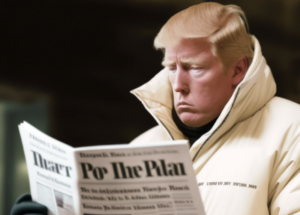$SPX $DJIA $BTC
#Trump #Maganomics #GDP #Economy #Markets #StockMarket #Investors #USPolitics #FinancialNews #EconomicPolicy #Growth #WallStreet
Investors appear to be dismissing the concerns of many economists over the potential economic impact of Donald Trump’s proposed “Maganomics,” a policy framework said to focus on tax cuts, deregulation, and infrastructure spending. While economists have warned of potential risks, particularly concerning fiscal deficits and slower GDP growth, the equity markets are signaling strong confidence. Leading stock indices, including the S&P 500 and Dow Jones Industrial Average, have been buoyed by investor optimism, reflecting a belief that Trump’s pro-business policies will spur corporate profitability and economic expansion. Market participants are clearly focusing on the immediate potential for regulatory rollbacks and corporate tax reform over longer-term macroeconomic uncertainties.
Economists, by contrast, have expressed concerns that the proposed policy mix under Maganomics could weigh heavily on long-term GDP growth. While the short-term impact of fiscal stimulus is likely to boost economic output, the associated ballooning of federal deficits could create strain in the wider economy. Rising borrowing costs, fueled by both higher government debt and Fed rate hikes, might further dampen growth prospects. Additionally, uncertainties around international trade policy, given Trump’s stated plans to renegotiate or exit certain trade agreements, have led to considerable debate. Critics argue there could be unintended consequences, including potential disruption to global supply chains, that make these policies inherently risky. Still, markets continue to reflect optimism as investors selectively focus on aspects of Trump’s agenda that are likely to deliver tangible returns to corporate bottom lines.
The divergence between economists’ cautious projections and the stock market’s ebullience highlights the complexity of analyzing such a consequential economic shift. Equity markets, inherently forward-looking, have gravitated toward Trump’s promises of significant tax reform and deregulation. Sectors like financials, industrials, and energy have seen notable gains since the election on expectations of policy shifts designed to remove barriers to business operations. For instance, industries tied to infrastructure, such as construction and manufacturing, have rallied amid promises of federal investment in public works. Investors appear to be assessing Maganomics pragmatically, evaluating the immediate financial implications for corporate profits rather than focusing on broader macroeconomic risks.
The question remains whether this optimism is sustainable or whether eventual realities will prompt recalibration in the markets. While deregulation and infrastructure spending might invigorate certain sectors, any missteps in trade policy or unsustainable deficit levels could result in downward pressure on equity prices in the medium to long term. Moreover, should the Federal Reserve respond aggressively to inflationary pressures arising from fiscal stimulus, interest rate hikes could further tighten financial conditions. For now, however, Wall Street seems content to ride the wave of optimism, embracing the potential for policy-driven returns even as underlying risks simmer beneath the surface.







Comments are closed.